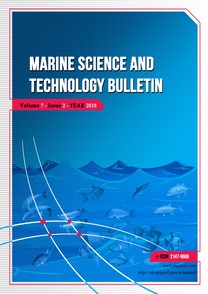Investigation of the Relationship Between Bioluminescence and the Production of α-Amylase of the First Bioluminescent Vibrio gigantis Strains From Izmir Bay
a-Amylase Bioluminescence, Izmir Bay, Vibrio gigantis,
___
- Al-Ghanayem, A. A., & Joseph, B. (2020). Current prospective in using cold-active enzymes as eco-friendly detergent additive. Applied Microbiology and Biotechnology, 104, 2871-2882. https://doi.org/10.1007/s00253-020-10429-x
- Al-Maqtari, Q. A., AL-Ansi, W., & Mahdi, A. A. (2019). Cold-active enzymes and their applications in industrial fields - a review. International Journal of Research in Agricultural Sciences, 6(4), 2348-3997.
- Arabacı, N., & Arıkan, B. (2018). Isolation and characterization of a cold-active, alkaline, detergent stable α-amylase from a novel bacterium Bacillus subtilis N8. Biochemistry and Biotechnology, 48(5), 419-426. https://doi.org/10.1080/10826068.2018.1452256
- Brodl, E., Winkler, A., & Macheroux, P. (2018). Molecular mechanisms of bacterial bioluminescence. Computational and Structural Biotechnology Journal, 16, 551-564. https://doi.org/10.1016/j.csbj.2018.11.003
- Burtseva, O., Kublanovskaya, A., Baulina, O., Fedorenko, T., Lobakova, E., & Chekanov, K. (2020). The strains of bioluminescent bacteria isolated from the White Sea fnfshes: genera Photobacterium, Aliivibrio, Vibrio, Shewanella, and first luminous Kosakonia. Journal of Photochemistry & Photobiology, B: Biology, 208, 111895. https://doi.org/10.1016/j.jphotobiol.2020.111895
- da Silva Nunes-Halldorson, V., & Duran, N. L. (2003). Bioluminescent bacteria: lux genes as environmental biosensors. Brazilian Journal of Microbiology, 34(2), 91-96. https://doi.org/10.1590/S1517-83822003000200001
- Ersoy Omeroglu, E. (2011). Isolation, phenotypic and molecular characterization of bioluminescent bacteria from Izmir Bay [Ph.D. Thesis. Ege University].
- Ersoy Omeroglu, E., & Karaboz, I. (2012). Characterization and genotyping by pulsed-field gel electrophoresis (PFGE) of the first bioluminescent Vibrio gigantis strains. African Journal of Microbiology Research, 6(43), 7111-7122. https://doi.org/10.5897/AJMR12.1775
- Ersoy Omeroglu, E., Karaboz, I., & Sudagidan, M. (2014). Characteristics and genetic diversity of bioluminescent Shewanella woodyi strains isolated from the Gulf of Izmir, Turkey. Folia Microbiologica, 59(1), 79-92. https://doi.org/10.1007/s12223-013-0269-z
- Erzinger, G. S., Schmoeller, F., Pinto, L. H., Américo, L., Hemmersbach, R., Hauslage, J., & Häder, D-P. (2018). Bioluminescence systems in environmental biosensors. In D. -P. Häder & G. S. Erzinger (Eds.), Bioassays: Advanced methods and applications (pp. 241-262). Elsevier.
- Fleiss, A., & Sarkisyan, K. S. (2019). A brief review of bioluminescent systems. Current Genetics, 65(4)i 877–882. https://doi.org/10.1007/s00294-019-00951-5
- Gopinath, S. C. B., Anbu, P., Arshad, M. K. Md, Lakshmipriya, T., Voon, C. H., Hashim, U., & Chinni, S. V. (2017). Biotechnological processes in microbial amylase production. BioMed Research International, 2017, 1272193. http://dx.doi.org/10.1155/2017/1272193
- Liu, P. C., Chuang, W. H., & Lee, K. K. (2003). Infectious gastroenteritis caused by Vibrio harveyi (V. carchariae) in cultured red drum, Sciaenops ocellatus. Journal of Applied Ichthyology, 19(1), 59–61. https://doi.org/10.1046/j.1439-0426.2003.00356.x
- Musa, N., Wei, L. S., & Wee, W. (2008). Phenotypic and genotypic characteristics of Vibrio harveyi isolated from black tiger shrimp (Penaeus monodon). World Applied Sciences Journal, 3, 885–902.
- Osawa, R., Okitsu, T., Sata, S., & Yamai, S. (1997). Rapid screening method for identification of choleratoxin-producing Vibrio cholera O1 and O139. Journal of Clinical Microbiology, 35, 951–953. https://doi.org/0095-1137/97/$04.0010
- Özcan, K., & Çorbacı, C. (2018). Streptomycetes sp. suşlarından amilolitik enzim üretimi [Production of amilolytic enzyme from Streptomycetes sp. strains]. Gümüşhane Üniversitesi Fen Bilimleri Enstitüsü Dergisi, 8(2), 185-191. https://doi.org/10.17714/gumusfenbil.310769
- Ramesh, C., & Mohanraju, R. (2015). A review on bioluminescence and its applications. International Journal of Luminescence and Applications, 5(1), 45-46.
- Santiago, M., Ramírez-Sarmiento, C. A., Zamora, R. A., & Parra, L. P. (2016). Discovery, molecular mechanisms, and industrial applications of cold-active enzymes. Frontiers in Microbiology, 7, 1408. https://doi.org/10.3389/fmicb.2016.01408
- Sharifian, S., Homaei, A., Hemmati, R., Luwor R. B., & Khajeh, K. (2018). The emerging use of bioluminescence in medical research. Biomedicine & Pharmacotherapy, 101, 74-86. https://doi.org/10.1016/j.biopha.2018.02.065
- Tanet, L., Martini, S., Casalot, L., & Tamburini, C. (2020). Reviews and syntheses: bacterial bioluminescence – ecology and impact in the biological carbon pump. Biogeosciences, 17, 3757-3778. https://doi.org/10.5194/bg-17-3757-2020
- Tanet, L., Tamburini, C., Baumas, C., Garel, M., Simon, G., & Casalot, L. (2019). Bacterial bioluminescence: light emission in Photobacterium phosphoreum is not under quorum-sensing control. Frontiers in Microbiology, 10, 365. https://doi.org/10.3389/fmicb.2019.00365
- Yaşa, İ., & Çadırcı, B. H. (2007). Mikrobiyal fizyoloji uygulama kitabı. Ege Üniversitesi Yayınları.
- ISSN: 2147-9666
- Yayın Aralığı: 4
- Başlangıç: 2012
- Yayıncı: Adem Yavuz SÖNMEZ
Impact of nutrient load coming from Göksu River on the northeastern Mediterranean
Barış Özsever, Leyla Tavacıoğlu
The effect of different processing methods on fishmeal element quality: Evaporator system
Barış Bayraklı, Hünkâr Avni Duyar
Mustafa GÜL, Barış BODUR, Mehmet AYDIN
Mohammad Amzad Hossain, Mohammed Mahbub Iqbal, Ripon Ali, Saddam Hossain, Gourab Chowdhury
Osman Tolga Özel, Selin Ertürk Gürkan
